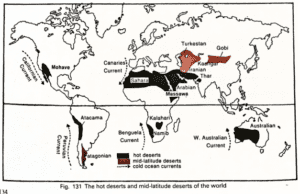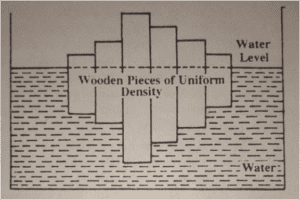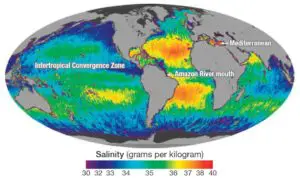Table of Contents
Understanding the Difference Between Anticline and Syncline
Anticlines and synclines are two fundamental geological structures commonly found in folded rock layers within the Earth’s crust. They are essential components of structural geology and provide valuable information about the history of rock deformation.
Difference Between Anticline and Syncline
What is Anticline?
- An anticline is a type of geological fold where rock layers or strata are folded into an arch or convex shape, resembling an upside-down “U” or a hill. The oldest rock layers are typically found in the center of the fold, while the younger layers are on the outer edges.
- Anticlines are often associated with compressional forces within the Earth’s crust, typically resulting from tectonic plate movements.
- These structures are important because they can trap and accumulate hydrocarbons (such as oil and gas) due to their upward-arching shape, forming potential reservoirs for these resources.
What is Syncline?
- A syncline is the adversary of an anticline. It’s a geological fold where rock layers are folded into a concave shape, resembling a “U” or a trough. In synclines, the youngest rock layers are usually in the center, while the older layers are found on the outer parts of the fold.
- Synclines often form in response to tectonic forces that result in stretching or extension of the Earth’s crust. These forces can cause rocks to bend downward and create synclinal structures.
- In contrast to anticlines, synclines are less likely to trap hydrocarbons, as they tend to have a more downward-facing structure.
What is Monocline?
A monocline is a type of geological fold or flexure in the Earth’s crust characterized by a single, steeply inclined set of rock layers or strata.
Unlike anticlines and synclines, which involve bending in both horizontal and vertical directions, monoclines primarily exhibit a simple, one-sided incline or dip in the rock layers.
Monoclines are often associated with regional tectonic forces and can be significant features in structural geology.
Key Characteristics of a Monocline:
- Steep Inclination: In a monocline, the rock layers are tilted or folded at a relatively steep angle, typically greater than 30 degrees, but it can be even steeper. This tilt is primarily in one direction, creating a step-like appearance in the landscape.
- Unidirectional: Unlike anticlines and synclines, which involve folding in both horizontal and vertical directions, monoclines primarily exhibit a single vertical or near-vertical flexure. This means that the rock layers are tilted along one main axis.
- Surface Expression: Monoclines can be seen on the Earth’s surface as topographic features where a relatively flat layer of rock is uplifted and inclined along one side, creating a step or ridge in the landscape. They can also be exposed in canyons, cliffs, or mountain ranges.
- Formation: Monoclines typically form in response to tectonic forces and stress within the Earth’s crust. These forces can cause the crust to bend and uplift, leading to the creation of monoclines.
Monoclines are essential in understanding the structural geology of a region and can have various geological implications, such as the potential for the localization of mineral deposits or the influence on groundwater flow patterns. They are also of interest to geologists and researchers studying the Earth’s history and the processes that shape its surface.
Fun Fact: The term “anticline” comes from the Greek words “anti,” meaning “opposite” or “against,” and “klinein,” meaning “to bend.” In contrast, the term “syncline” comes from the Greek words “syn,” meaning “together,” and “klinein,” meaning “to bend.”
Significance of Anticlines and Synclines in Geology
Anticlines and synclines play a crucial role in understanding the geological history of an area. They provide valuable information about the forces that have shaped the Earth’s crust and help geologists determine the sequence of rock layers in folded mountain belts or sedimentary basins. Understanding the characteristics and formation processes of these structures
Mutiple Choice Questions
1. What is an anticline?
a) A type of geological fold where rock layers are folded into a concave shape.
b) A type of geological fold where rock layers are folded into an arch or convex shape.
c) A single, steeply inclined set of rock layers or strata.
d) A type of geological fold where rock layers are gently inclined in one direction.
Explanation: An anticline is a type of geological fold where rock layers are folded into an arch or convex shape, resembling an upside-down “U” or a hill. The oldest rock layers are typically found in the center of the fold, while the younger layers are on the outer edges.
2. What is the main characteristic of an anticline?
a) It is associated with compressional forces within the Earth’s crust.
b) It is the adversary of a syncline.
c) It tends to trap and accumulate hydrocarbons.
d) It is less likely to trap hydrocarbons.
Explanation: The main characteristic of an anticline is that it is associated with compressional forces within the Earth’s crust, typically resulting from tectonic plate movements.
3. What is a syncline?
a) A type of geological fold where rock layers are folded into an arch or convex shape.
b) A type of geological fold where rock layers are folded into a concave shape.
c) A single, steeply inclined set of rock layers or strata.
d) A type of geological fold where rock layers are gently inclined in one direction.
Explanation: A syncline is a geological fold where rock layers are folded into a concave shape, resembling a “U” or a trough. In synclines, the youngest rock layers are usually in the center, while the older layers are found on the outer parts of the fold.
4. What is the main characteristic of a syncline?
a) It is associated with compressional forces within the Earth’s crust.
b) It is the adversary of an anticline.
c) It tends to trap and accumulate hydrocarbons.
d) It is less likely to trap hydrocarbons.
Explanation: The main characteristic of a syncline is that it is the adversary of an anticline. It forms in response to tectonic forces that result in the stretching or extension of the Earth’s crust, causing rocks to bend downward and create synclinal structures.
5. What is a monocline?
a) A type of geological fold where rock layers are folded into an arch or convex shape.
b) A type of geological fold where rock layers are folded into a concave shape.
c) A single, steeply inclined set of rock layers or strata.
d) A simple, one-sided incline or dip in the rock layers.
Explanation: A monocline is a type of geological fold or flexure characterized by a single, steeply inclined set of rock layers or strata. It primarily exhibits a simple, one-sided incline or dip in the rock layers.
6. What is the main characteristic of a monocline?
a) Steep inclination
b) Folding in both horizontal and vertical directions
c) Formation from compressional forces within the Earth’s crust
d) Localization of mineral deposits
Explanation: The main characteristic of a monocline is its steep inclination. The rock layers are tilted or folded at a relatively steep angle, typically greater than 30 degrees, creating a step-like appearance in the landscape.
7. What can monoclines tell us about a region?
a) The potential for the localization of mineral deposits
b) The history of rock deformation
c) The influence on groundwater flow patterns
d) The processes that shape the Earth’s surface
Explanation: Monoclines are essential in understanding the structural geology of a region and can have various geological implications, such as the potential for the localization of mineral deposits or the influence on groundwater flow patterns. They also help researchers study the Earth’s history and the processes that shape its surface.
Brief Summary | UPSC – IAS
Anticlines and synclines are geological structures found in folded rock layers. Anticlines are arch-shaped folds with older rock layers in the center and are often associated with compressional forces. They can trap hydrocarbons and form reservoirs. Synclines are concave folds with younger rock layers in the center, formed by stretching forces. They are less likely to trap hydrocarbons. Monoclines are steeply inclined folds with a single direction of tilt and are formed by tectonic forces. They can be important for understanding structural geology, mineral deposits, and groundwater flow patterns.



